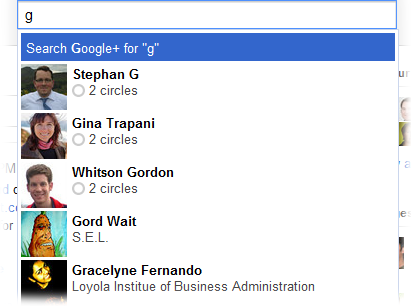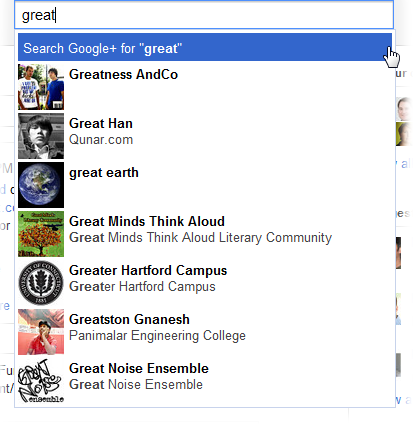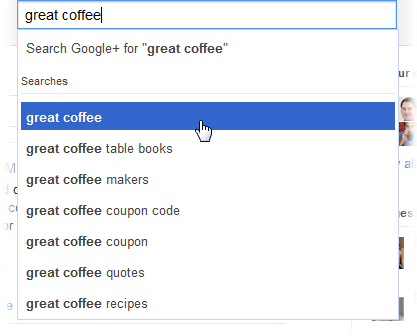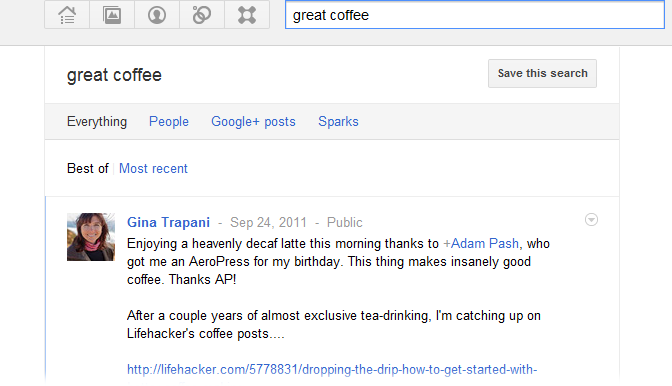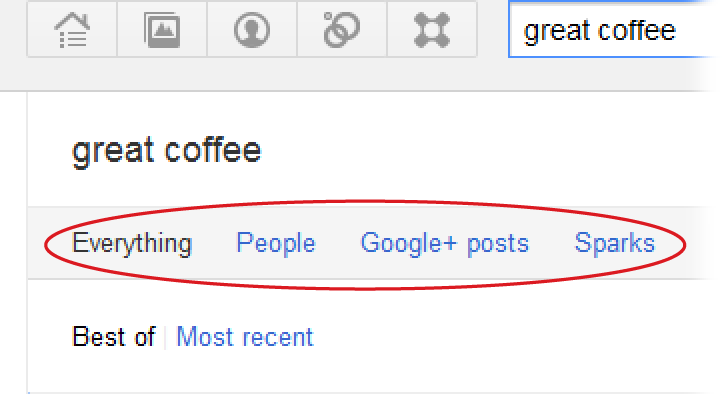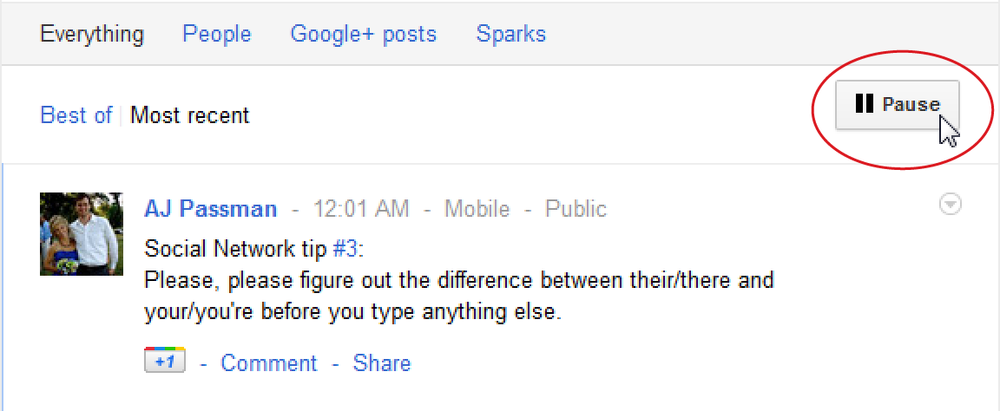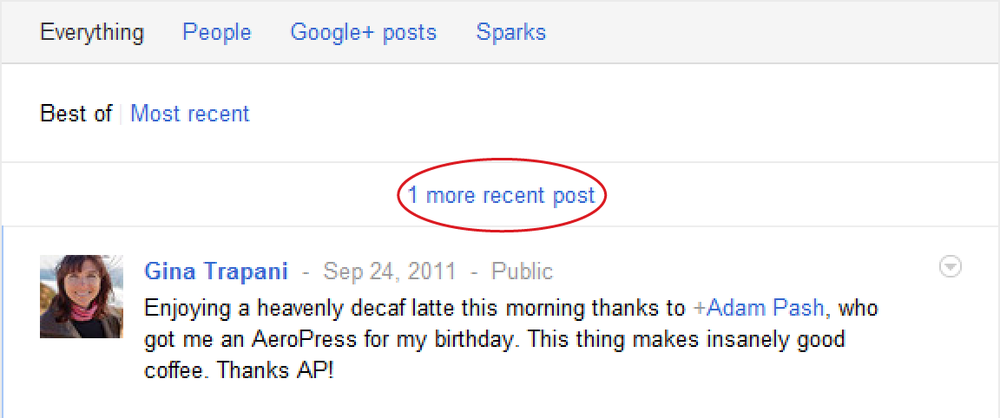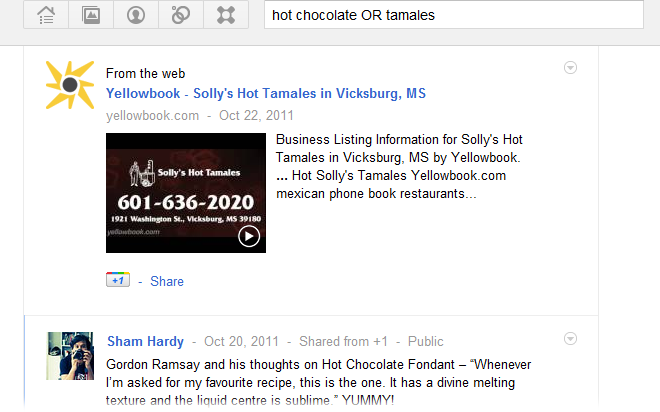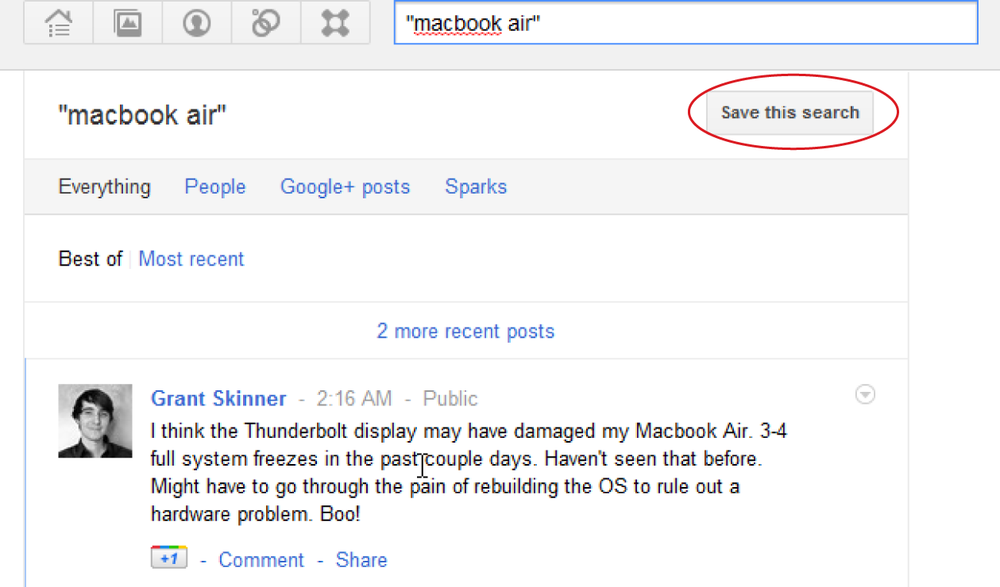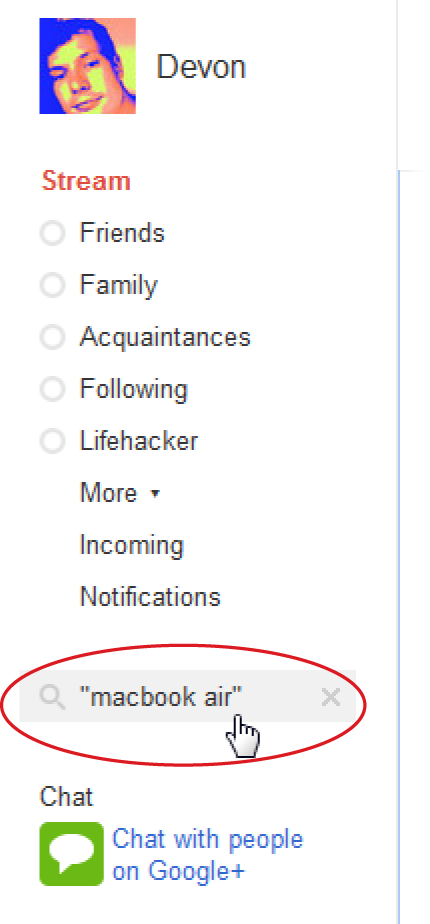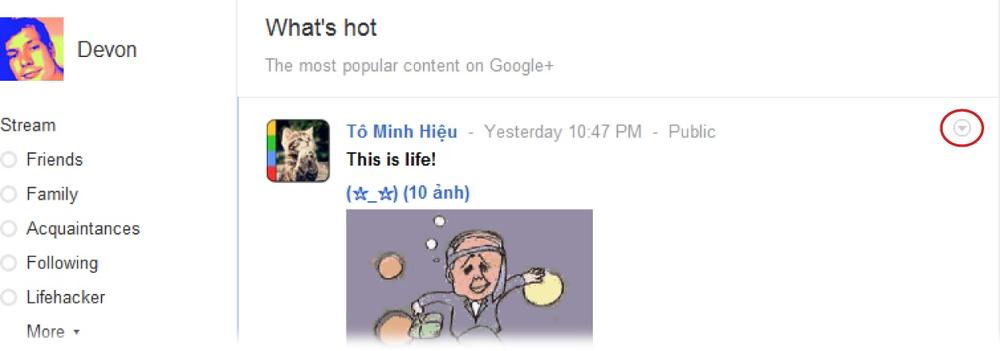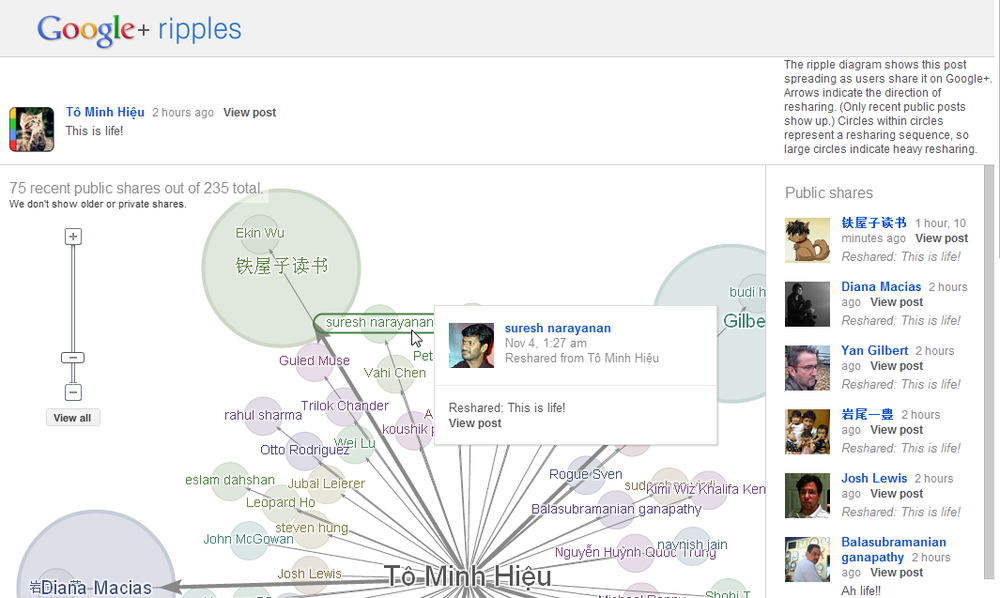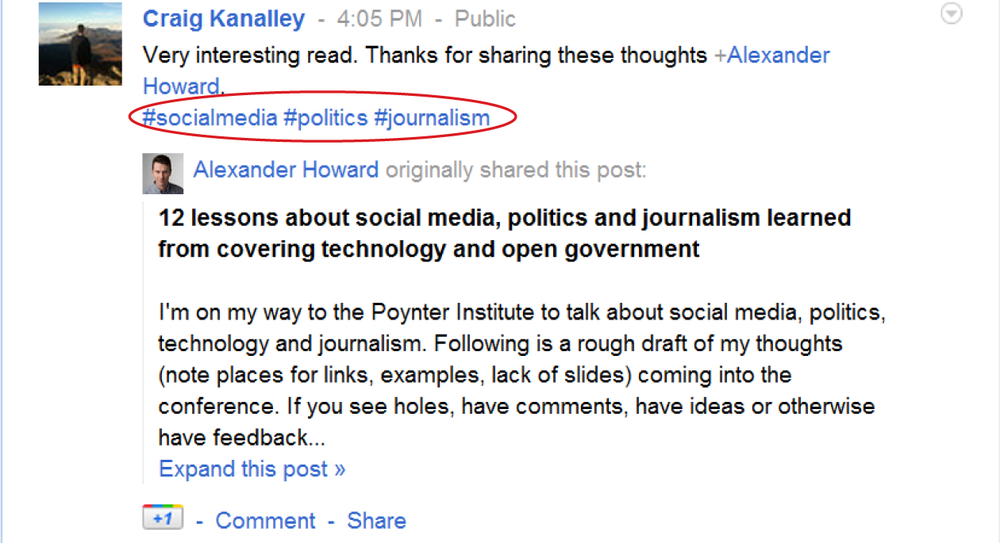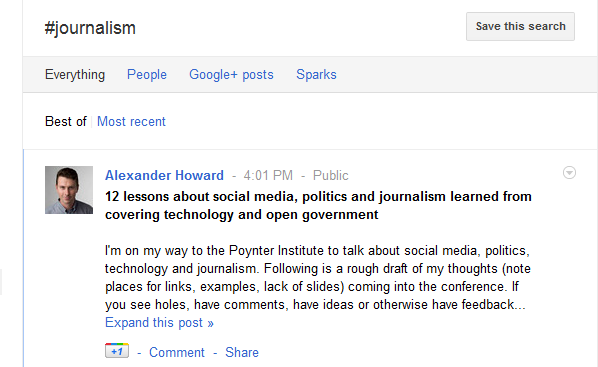Chapter 7. Searching and Sparks
GOOGLE+ GIVES YOU CIRCLES, streams, and notification tools so you can keep up with your friends, speak your mind, and monitor and control what’s going on with your online social life. The site also gives you a way to search out people, topics, and just about anything else that’s been shared publicly by someone using Google+, whether you know the people who put it out there or not. Google+ also gives you a personalized stream of news articles and blog posts, dubbed sparks, and the ability to make your own news and commentary into potential search results by labeling posts and photos with hashtag markers. This may sound a bit confusing and technical, but it’s actually quite simple once you get the hang of it. This chapter will get you up to speed in no time.
Searching Google+
IT’S NO SURPRISE THAT the search bar is a prominent part of every Google+ page (Google made its name as a search engine, after all). The search bar is at the top of every page, with “Search Google+” written inside.
As you know, if you go to Google.com and enter a search term, you’ll get results from all over the Internet. The Google+ search bar, on the other hand, scours only Google+. You’ll get results that are a mixture of things specific to your Google+ account, and the wider world of things people have posted publicly on the site. Simply click in the box, start typing, and you’ll see how that works. You don’t even have to hit Enter (Return on a Mac) to see what it finds—even if you just type one letter, Google+ will display a drop-down list with a bunch of suggestions.
Since Google+ is all about connections between people, it guesses that you might be looking for people in your circles, so it puts people in your circles whose names contain the letter you typed near the top of the list. Click any of these folks and you’ll arrive at their profile page. This is a much easier way to see what someone has been posting about than heading into your Circles page and finding them there.
Keep typing, and the results change to reflect what you add. Type great, for example, and since it’s unlikely that any of your friends are named Great, the search results include a host of organizations whose names have “great” in them.
What you’re really looking for, though, is great coffee (aren’t you always?). Enter that whole phrase, and Google+ runs out of people and organizations whose names match what you’ve typed, so it provides related search terms instead: “great coffee table books,” “great coffee makers,” “great coffee coupon,” and so on. If one of those phrases if what you want, click it to search Google+ for it.
But you’re after plain ol’ great coffee: people who’ve mentioned finding great coffee in a Google+ post, people whose profiles indicate that they love great coffee, maybe even news stories people have shared about great coffee. To search for exactly what you’ve typed, simply hit Enter (Return on a Mac) or click the first item in the drop-down list (Search Google+ for “[whatever you typed]”).
Note
The search results shown in this chapter will almost certainly look different than the ones you’ll get if you search for the same terms because you’re connected to different people and will perform the search at different times. Also, search is one of the more rapidly-changing features of Google+.
Google+ brings up your search results, which are tailored to your account. In the “great coffee” search example previously, the top result is a post from Gina Trapani. Why is that? Because she’s in one of the searcher’s circles, and because of the way the search is filtered. The following sections explain the various filter settings.
Note
If there are Google+ members who match your search terms, you’ll see a small grid of their profile pictures and names at the top of your search results, along with a “View all” link to see more folks who match. For example, do a search for “cheese” and you’ll see results that include everyone whose name includes that word, as shown in the following illustration.
The Four Types of Google+ Search Results
When you perform a Google+ search, the results page that appears gives you a few ways to whittle down your results. In the gray bar below your search term are four categories:
Everything. Google+ selects this category automatically. (You can tell which category is selected because its name is written in gray; the other categories’ names are in blue to indicate you can click them to switch to them). When it’s selected, the results you see are a compilation of posts, Google+ members, and results from sparks (explained in a sec).
People. Click this category to see a list of people using Google+ who have your search term in their name or profile. You see each person’s name, the occupation listed in their profile, a snippet of the first bit of their profile, and an “Add to circles” button you can mouse over to pull up a list of your circles to add this person to. (If the person is already in one or more of your circles, you’ll see a button indicating the name of the circle[s] instead.)
Google+ posts. Click this category and you’ll see text, photos, videos, and links from people in your circles, as well as from people you don’t know who’ve posted things publicly on Google+.
Sparks. This category is the least straightforward. It displays a kind of curated feed of news and blog items related to your search. The box below has details.
Best of vs. Most Recent
Below the four categories described in the previous section, and below any people that Google+ lists at the top of some search results, are two more links you can use to filter your results: “Best of” and “Most recent.” Google+ automatically displays search results in “Best of” order. What criteria does Google+ use to rank “Best of” results? They aren’t really telling, but it appears that posts are higher up in the “Best of” results for a given topic if they:
Have lots of comments, +1s, and shares.
Were written by people in your circles, in your suggested contacts, or in your contact’s circles.
Have all of the terms you’re searching for close together. So if you searched for “great coffee,” posts that include that exact phrase are ranked higher than posts that simply have “great” and “coffee” separately.
Have a photo or link attached.
Clicking “Most recent” gives you exactly that—a list of relevant results from the category you selected, with the latest ones on top.
Real-time search results
One thing to note about Google+ search results is that they stay up-to-date, no matter how long ago you searched. The easiest way to see this in action is to click “Most recent.” Assuming you search for a relatively active topic (like an upcoming holiday or something related to a breaking news story), you’ll see that Google+ is actively checking for newer results. As you watch, the search results page will update automatically, with newer, fresher results appearing at the top of the list.
If you’re viewing the “Most recent” results and trying to catch up or want to hold certain stories in place, click the Pause button near the top of the search results. (If you don’t see the Pause button right away, it should appear when more results are added to the page.) To go back to automatically seeing the freshest stuff as it comes in, click the same button again, which now reads (you guessed it) Play.
When you have “Best of” selected instead, the updates happen in more methodical fashion. A message appears at the top of your original search results letting you know how many new results Google+ has found since you searched. Click that link, and the page will update to include those items.
Getting Better Results
YOU CAN GET MORE precise search results from Google+ by using modifiers to clarify exactly what you’re looking for. Here’s how to use them to get the most relevant results on Google+.
Note
The tips in the following sections also work when you’re searching the Web using Google.com.
Finding Exact Phrases
Putting multiple words (or one word that has multiple spellings) into quotation marks tells Google+ you want to find that exact phrase (or spelling) only, rather than items that happen to include all the words somewhere in them.
For example, search for monster trucks, with no quotation marks, and you’ll get one set of results. Some of them will likely include the actual phrase “monster trucks,” but some will simply contain the words “monster” and “trucks” (like a post that says “The local Ford dealer is having a monster sale on trucks!”). Now search “monster trucks”, with quotes, and you’ll likely see some different results (though some may be the same). All the results will include that exact phrase, not just the words within it.
Quotation marks also prevent Google from searching for possible synonyms and alternate spellings of your search terms. If you search for “healthcare” (with quotes), for instance, your results will only include that exact word and exclude items that mention health care (two words).
Excluding Terms
Certain things are just hard to search out these days. For example, what if you want to see what’s happening in Fiji the island nation without having to sort through chatter about Fiji the bottled water brand? Even more difficult: What if you’re interested in learning about robots designed to look like humans (androids) but not Google’s much-written-about phone operating system (Android)?
That’s when you pull out the minus sign (a.k.a. hyphen). Put a minus sign directly in front of a word, with no space, and Google+ won’t bring back search results that have that term in them. You can add as many excluded terms as you’d like to narrow things down and get to the results you’re looking for.
Say you do a search for android. Most of your results will be about the Android operating system. Even if you add “science fiction”, with exact-phrase-please quotation marks, you’ll still get more stories about phones than robo-people.
That’s when excluding terms comes in handy. To keep techie types and phone obsessives out of your results, add -phone, -smartphone, and even -google to your search terms. Sure, you might miss a few science fiction-minded items that happen to mention Google searches, but overall, the results are much more precise.
Searching for Multiple Terms
Quotation marks and minus signs help you pare down your results, but sometimes you’re feeling expansive. You might, for example, want to see posts about both Korean and Vietnamese restaurants in a certain town, rather than having to search them out separately. To do so, type OR—in all caps—between two swapable, either/or terms. In the restaurant example, you’d type “San Francisco” Korean OR Vietnamese restaurant to see posts about either type of cuisine in the city by the bay. Or say you’re craving both cocoa and Mexican food; in that case, you might search out hot chocolate OR tamales. The first few results might be hot chocolate-related, because it’s the more popular item. But scroll down a bit, and you’ll see that both chocolate and tamales are represented.
You can combine quotation marks, minus signs, and OR for some super specific results. Searching for “hot chocolate” OR “dark chocolate” -Ghirardelli, for example, is one way to really drill down on your high-falutin’ sweet tooth.
Tip
You can read more Google search tips by checking out Google’s own advice for advanced searching at http://tinyurl.com/cnl73j. Not all the tips apply to Google+ (like searching within a website, obviously), but most of them will make you better at finding posts hidden in plain sight.
Saving Searches
SEARCHING GOOGLE+ GIVES YOU the latest and most active posts and news on a topic, but searching out the stuff you’re interested in every time you sign into Google+ can be a hassle, especially if you use long, complicated search terms to find exactly what you want. Happily, Google+ lets you save your search phrases by clicking the “Save this search” button in the upper-right corner of every search-result page.
Whatever you searched for becomes a saved search, which means you can run a new search on that same phrase by clicking it on the left side of your Home page, where it appears below the list of your circles. (The little magnifying glass icon makes it clear that it’s a search term, not a circle.) To delete a saved search, simply mouse over the term, and an X will appear that you can click to delete the search.
Note that any of the modifiers you used in your search (like quotation marks) are kept intact in a saved search. And just like with a regular search, you can filter the results to see just people’s names, Google+ posts, or sparks, and sort by either the best matches or the most recent stuff.
Tip
Google+ makes saving searches convenient, but you can keep more direct tabs on topics in Google+ and access them without needing to have Google+ open in your browser or be signed into your Google account, using either of these browser tricks:
Bookmark the link for a saved search by clicking the saved search on your Google+ Home page and then dragging it to your bookmark toolbar. Alternately, you can run the search, and then either copy the link in your browser’s address bar, or click the + icon at the left end of your browser’s address bar and drag the link from the bar onto your desktop or another convenient location.
Open a saved search in a new browser tab by holding the Ctrl key (the ⌘ key on a Mac) while clicking the search’s link, or by right-clicking the search’s link and choosing “Open link in new tab” (or something similar). Keep the results fresh by changing the sorting to “Most recent,” or by checking in occasionally and clicking the “X more recent post(s)” link.
“What’s Hot” Searches and Ripples
Just above your list of saved searches is a “What’s hot” link with a little flame icon next to it. Click this link to see the Google+ posts that are currently getting the most +1s, comments, and shares per minute out of all the content on Google+. Most (if not all) of the posts will be by folks you don’t know, but you might still find some of them interesting. Running a “What’s hot” search isn’t terribly useful, but it can be a good way to kill some time. If nothing else, you’ll probably see many different kinds of posts that you wouldn’t normally see in your stream—for better or for worse.
If you’re curious how a post got popular enough to make the “What’s Hot” list, click the down arrow in the upper-right corner of the post (circled in the previous illustration), and choose the View Ripples option. This option appears only on public posts that have gained significant popularity. Your own public posts, or posts you share, may even end up with a View Ripples option, if they become popular enough. When you select this option, you’ll see a spiffy diagram that shows who shared the post with whom.
Throw Your Post into the Mix with Hashtags
GOOGLE’S GOOD AT SEARCHING, and as you’ve seen, Google+ includes some powerful search tools. But you and Google don’t have to do all the heavy lifting. In some cases, people will categorize what they post and make it easy to find using a tool that originated on Twitter: hashtags.
Hashtags are a word or phrase preceded by the pound sign (#). (In British vernacular and in computer parlance, that symbol is called a “hash.”) By adding a # in front of a word (#SuperBowl, perhaps, or #election2012), Twitter users organize their short updates. Because few people would otherwise write something like “#winning” as part of a message, anybody searching for “#winning” only finds messages where the author intentionally added that hashtag, not every post where someone happened to use the word “winning.” So hashtags are a simple way for searchers find messages about a certain topic. They can also give context to otherwise inscrutable posts (“Nice shot Brazil! #worldcup”). Hashtags can even serve as punchlines or indicate that there’s some irony at play: “Woke up at 11, ate cereal for lunch, spent afternoon reprogramming remote #Funemployment.”
Tip
There’s no list of “correct” or “approved” hashtags out there—people just make ’em up on the fly. So you don’t have to wait to make sure you’ve seen someone else use a particular hashtag before you add it to one of your posts—you can create them with just a pound sign and a thought. Some catch on and get used by lots of people, others are just one-offs.
The inventor of hashtags, Chris Messina, now works for Google, and hashtags themselves have become a cultural phenomenon. So it makes sense that Google+has incorporated hashtags into its search abilities. When you or another Google+member adds a hashtag to a post, the hashtag shows up as a clickable link.
Tip
Since Google+ doesn’t limit the length of your posts like Twitter does, you can include as many hashtags as you want.
Click a hashtag, and Google+ automatically runs a search for other posts that include that hashtag.
In your search results, you might not see the hashtag itself in the part of the post displayed in the result, but it’s in there somewhere—either later in the post (click “Expand this post” to see the rest) or in the comments. And that’s the point of adding hashtags: writing about a topic, not worrying about what searchable terms you’ve used, and then letting your hashtags do the librarian work of categorizing it.
As you might imagine, hashtag searches make for great saved searches, because they’re more focused and less likely than all but the most specific searches to include unrelated results. They also help you find particular posts. For example, if you knew that John Smith wrote something recently and hashtagged it with “#sabres,” you can just search for “John Smith #sabres” to pinpoint John’s comments about that (great) hockey team without having to sort through his other posts about hockey.
That’s the skinny on searching, sorting, and saving, as well as using and searching for hashtags on Google+. They’re all skills you get better at by trying, and it’s really hard to harm anything by doing so, so test the limits of what you can find and start adding hashtags to your posts. Next up, a look at how to do almost everything you’ve learned in your web browser on the smaller screens of mobile devices.


